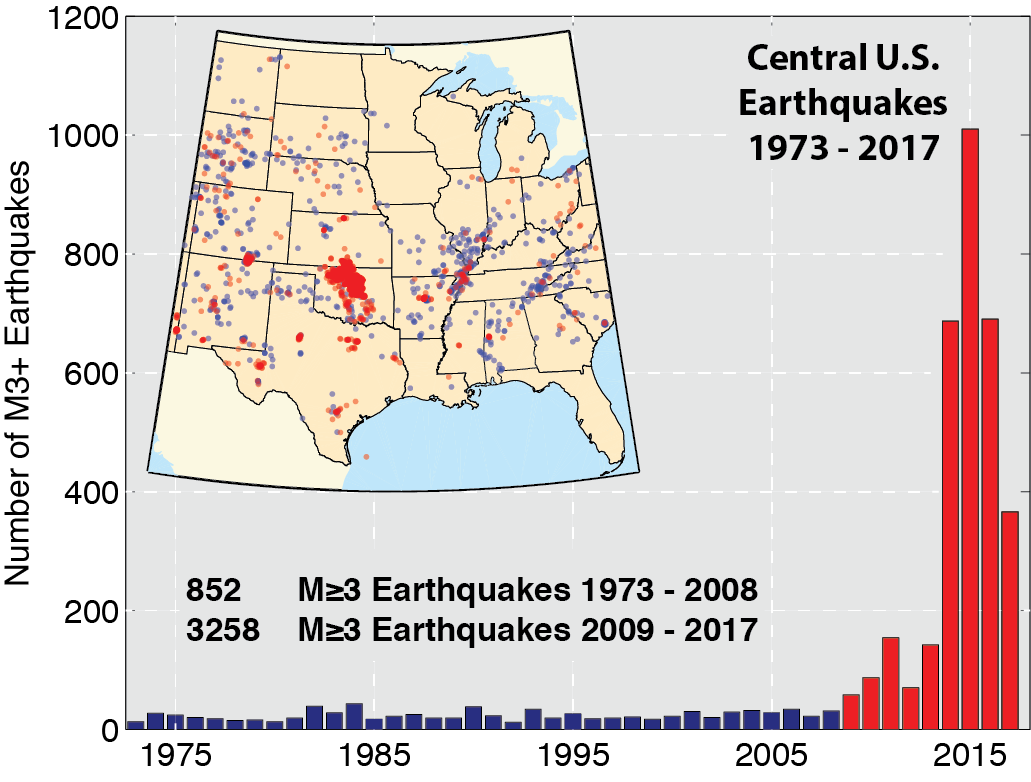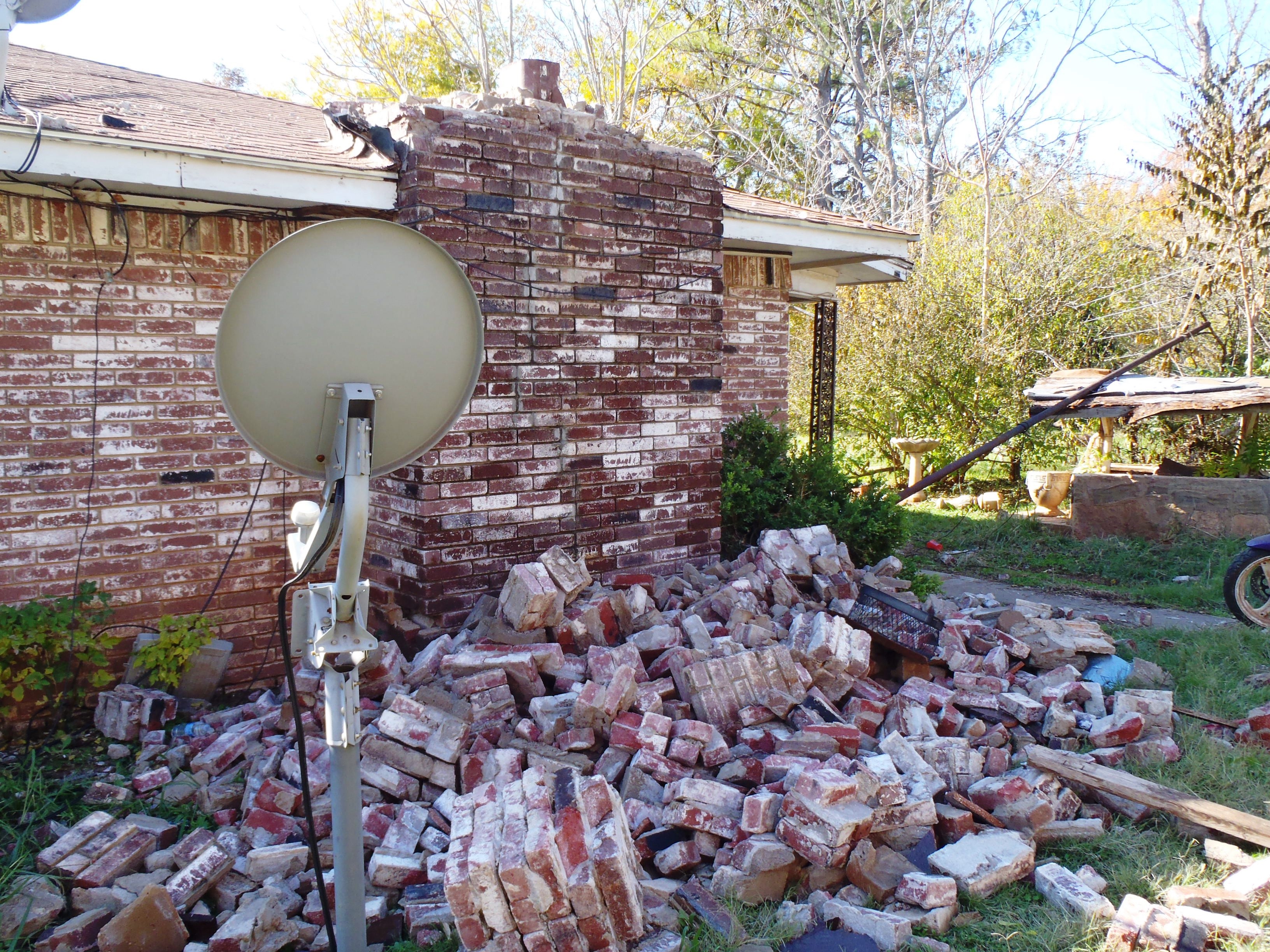Induced Seismicity from Oil and Gas Operations
Earthquakes caused by wastewater disposal and hydraulic fracturing
Manmade Earthquakes
Any activity that significantly changes the pressure on or fluid content of rocks has the potential to trigger earthquakes. This includes geothermal energy production, water storage in large reservoirs, groundwater extraction, underground injection of water for enhanced oil recovery, and large-scale underground disposal of waste liquids.1 The fact that underground fluid injection can trigger damaging earthquakes has been understood since the 1960s, but historically such earthquakes have been very rare.2 The sharp rise in noticeable earthquakes in the central United States from 2008 to 2015 was caused by massive increases in the underground disposal of produced water from the oil and gas industry.3 Since mid-2015, declining rates of produced water disposal have led to fewer earthquakes in the central United States.
Hydraulic fracturing has caused some small earthquakes, but these are comparatively unusual: in a 2016 study of Canadian wells, 0.3% of hydraulically fractured wells were linked to earthquakes of at least magnitude 3.4

The sharp rise in small but noticeable earthquakes in the central United States, caused largely by huge increases in the underground disposal of produced water from oil and gas production. M = magnitude (see blue box). Image credit: U.S. Geological Survey.5
Earthquakes Caused by Wastewater Disposal
In the central United States, particularly in central Oklahoma and south-central Kansas, the oil and gas boom in the early 2000s vastly increased the amount of produced water in need of disposal. Across the region, as more water was injected in deep disposal wells, earthquake activity increased:
- In Oklahoma, wastewater disposal rates tripled from 1 million barrels per day in 2010 to almost 3 million in 2014. Before 2008, Oklahoma had only a few earthquakes larger than magnitude 3 (M>3) per year; in 2014 the state had 579; and in 2015 there were 903 M>3 earthquakes in Oklahoma. These earthquakes clustered in areas with many large-volume disposal wells, strengthening the link between underground water disposal and induced earthquakes.3 In 2015, underground water disposal began to decline, and in 2016 the number of M>3 earthquakes decreased to 623. This decline in underground disposal of produced water reflects both reduced production (due to lower oil prices) and state regulations.3
- In south-central Kansas, deep wastewater disposal volumes increased roughly tenfold from 2011 to 2014. In Harper and Sumner counties, which historically do not experience M>3 earthquakes in most years, over 100 M>3 earthquakes were recorded in 2015.11 From 2015, decreasing injection volumes were followed by a decrease in earthquakes, and in 2016 there were fewer than 20 M>3 earthquakes in all of Kansas.12 In 2017, Kansas saw slightly more earthquakes, but overall earthquake activity remained low.
- Texas went from having roughly two M>3 earthquakes per year before 2008 to around 12 per year from 2011 to 2016.13
Other areas that have seen noticeable earthquakes induced by wastewater disposal (in much lower numbers than Oklahoma) include Colorado, New Mexico, Arkansas, Ohio, and Wyoming.

Damage caused by the magnitude 5.7 earthquake near Prague Oklahoma, November 6, 2011. Unreinforced stone and brick buildings (especially chimneys) are some of the most vulnerable structures in any earthquake. Image credit: Brian Sherrod, U.S. Geological Survey.10
Earthquakes Caused by Hydraulic Fracturing
Hydraulic fracturing does not generally cause earthquakes large enough to be felt (M>3), but there have been some exceptions:
- A study in Canada linked roughly 0.3% of hydraulically fractured wells to M>3 earthquakes.4 Although most of these earthquakes occur close to and at the same time as hydraulic fracturing operations, a small percentage of induced earthquakes may occur months later.14
- In Ohio, both Poland Township (2014) and Harrison County (2015) have experienced M3 earthquakes caused by hydraulic fracturing.3,15
- In Oklahoma, some small (mostly ≤ M3) earthquakes have been linked to hydraulic fracturing in a small proportion of hydraulically fractured wells.3
Earthquake Risk Management and Mitigation by States
State regulators focus on identifying the precise location and magnitude of an earthquake and then determining its cause. If earthquakes are linked to wastewater injection, regulators can instruct operators to cease or limit injection rates and water volumes in nearby wells.16,17 Many regulators also require that new injection wells avoid areas near known active faults. In Oklahoma, these techniques have effectively reduced the number of felt earthquakes.3 Similar procedures have been applied to hydraulic fracturing operations in some states (e.g., Ohio): if earthquakes are detected, operations must be modified or suspended.3
References
1 National Research Council (2013). Induced Seismicity Potential in Energy Technologies
Accessed from: https://www.nap.edu/catalog/13355/induced-seismicity-potential-in-energy-technologies
2 Nicholson, C. and Wesson, R.L. (1990). Earthquake Hazard Associated with Deep Well Injection – A Report to the U.S. Environmental Protection Agency. U.S. Geological Survey Bulletin 1951.
Accessed from: https://pubs.usgs.gov/bul/1951/report.pdf
3 American Geosciences Institute (2017). State Responses to Induced Seismicity.
Accessed from: https://www.youtube.com/watch?v=Q_jeWHqiIvE&list=PLTBBygdCOWWeAnaAcLu1r-rwZYPx64Hyw&index=35
4 Atkinson, G. et al. (2016). Hydraulic Fracturing and Seismicity in the Western Canada Sedimentary Basin. Seismological Research Letters, 87(3), 631-647.
Accessed from: https://pubs.geoscienceworld.org/ssa/srl/article-abstract/87/3/631/315665/hydraulic-fracturing-and-seismicity-in-the-western
5 U.S. Geological Survey – Induced Earthquakes: Overview.
Accessed from: https://earthquake.usgs.gov/research/induced/overview.php
6 Veil, J. (2015). U.S. Produced Water Volumes and Management Practices in 2012.
Accessed from: http://www.veilenvironmental.com/publications/pw/prod_water_volume_2012.pdf
7 U.S. Geological Survey – Do all wastewater disposal wells induce earthquakes?
Accessed from: https://www.usgs.gov/faqs/do-all-wastewater-disposal-wells-induce-earthquakes
8 U.S. Geological Survey (2017) – Short-term Induced Seismicity Models.
Accessed from: https://earthquake.usgs.gov/hazards/induced/
9 U.S. Geological Survey - Earthquake Catalog.
Accessed from: https://earthquake.usgs.gov/earthquakes/search/
10 U.S. Geological Survey – House Damage from 2011 Oklahoma Earthquake.
Accessed from: https://www.usgs.gov/media/images/house-damage-2011-oklahoma-earthquake
11 Kansas Geological Survey (2017). Update on Kansas Seismicity: A Year of Change, What Does it Mean?
Accessed from: http://www.kgs.ku.edu/PRS/Seismicity/2017/KS_Seismicity_KDHE_Wichita_08_30_17_V4.pdf
12 Kansas Geological Survey (2018). Number of Earthquakes Each Month, 2013 to Date.
Accessed from: http://www.kgs.ku.edu/PRS/Seismicity/2018/Kansas_earthquake_frequency.pdf
13 Frohlich, C. et al. (2016). A Historical Review of Induced Earthquakes in Texas. Seismological Research Letters, 87 (4), 1022-1038.
Accessed from: https://pubs.geoscienceworld.org/ssa/srl/article-abstract/87/4/1022/314110/a-historical-review-of-induced-earthquakes-in
14 Bao, X. and Eaton, D.W. (2016). Fault activation by hydraulic fracturing in western Canada. Science, 354, 1406-1409.
Accessed from: http://science.sciencemag.org/content/early/2016/11/16/science.aag2583.full
15 Skoumal, R. et al. (2015). Earthquakes Induced by Hydraulic Fracturing in Poland Township, Ohio. Seismological Society of America Bulletin, 105(1), 189-197.
Accessed from: https://pubs.geoscienceworld.org/ssa/bssa/article-abstract/105/1/189/323441
16 Ground Water Protection Council and Interstate Oil and Gas Compact Commission (2015). Potential Injection-Induced Seismicity Associated with Oil and Gas Development: A Primer on Technical and Regulatory Considerations Informing Risk Management and Mitigation.
Accessed from: http://www.gwpc.org/sites/default/files/finalprimerweb.pdf
17 U.S. Environmental Protection Agency, Underground Injection Control National Technical Workgroup (2015). Minimizing and Managing Potential Impacts of Injection-Induced Seismicity from Class II Disposal Wells: Practical Approaches.
Accessed from: https://www.epa.gov/sites/production/files/2015-08/documents/induced-seismicity-201502.pdf
18 Chen, X. et al. (2017). The Pawnee earthquake as a result of the interplay among injection, faults, and foreshocks. Scientific Reports, 7, 4945.
Accessed from: https://www.nature.com/articles/s41598-017-04992-z
Induced Seismicity: Fast Facts and Figures
- 2.5 billion gallons of water are produced every day in the U.S. from about 900,000 oil and gas wells.6 That’s 7.5 gallons per U.S. resident per day.
- Roughly 90% of all produced water is injected6 into roughly 150,000 wells: 40,000 are used only for wastewater disposal and the rest inject water for enhanced oil recovery.7
- Earthquakes caused by underground wastewater disposal have been most common and powerful in Oklahoma.8
- In Oklahoma, earthquake activity peaked in early 2015, with roughly three M>3 earthquakes every day.9 From early 2015 to early 2017, earthquake activity decreased to less than one M>3 earthquake per day as less wastewater was injected underground.3
Produced Water
Most oil- and gas-bearing rocks also contain water. When this is extracted along with oil and gas, it is called “produced water”. For more on produced water reuse and disposal, see “Using Produced Water” in this series.
Earthquake Magnitude (M)
Earthquake magnitude (M) describes the amount of energy released by an earthquake. For every two units of magnitude, the energy release is roughly 1000 times larger. M3 and larger can often be felt, and M5 can cause moderate damage. The largest earthquakes are all naturally occurring and can reach M9 or greater. Underground wastewater disposal has been linked to earthquakes as large as M5.8 in Oklahoma.18
Table of Contents
- #1: Petroleum and the Environment: an Introduction
- #2: Water in the Oil and Gas Industry
- #3: Induced Seismicity from Oil and Gas Operations
- #4: Water Sources for Hydraulic Fracturing
- #5: Using Produced Water
- #6: Groundwater Protection in Oil and Gas Production
- #7: Abandoned Wells
- #8: What Determines the Location of a Well?
- #9: Land Use in the Oil and Gas Industry
- #10: The Pinedale Gas Field, Wyoming
- #11: Heavy Oil
- #12: Oil and Gas in the U.S. Arctic
- #13: Offshore Oil and Gas
- #14: Spills in Oil and Natural Gas Fields
- #15: Transportation of Oil, Gas, and Refined Products
- #16: Oil Refining and Gas Processing
- #17: Non-Fuel Products of Oil and Gas
- #18: Air Quality Impacts of Oil and Gas
- #19: Methane Emissions in the Oil and Gas Industry
- #20: Mitigating and Regulating Methane Emissions
- #21: U.S. Regulation of Oil and Gas Operations
- #22: Health and Safety in Oil and Gas Extraction
- #23: Subsurface Data in the Oil and Gas Industry
- #24: Geoscientists in Petroleum and the Environment
- Glossary of Terms
- Full Reference List
